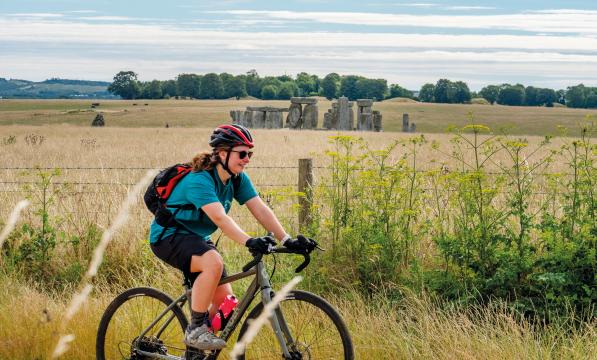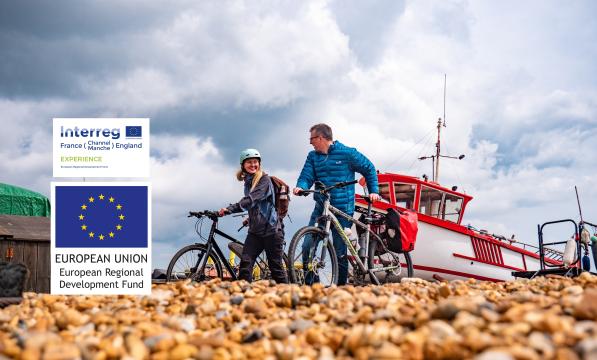How to transport your bike by car or train

Plan your journey
Exploring new places is one of the great joys of cycling. The first tip is to look at the places you want to go to on your cycling adventure and work out if it’s best to cycle from home, drive and park or cycle from the nearest train station. Some of our Cycling UK routes start at train stations, so there’s lot of routes to inspire you.
You can create your own with our journey planner or use it as a tool to explore your options in the area. Furthermore, if you are cycling in Cornwall, Kent and Norfolk our EXPERIENCE hubs and maps will give you extra details and lots of inspiration.
Planning ahead will make the whole cycling adventure less stressful and help you have a better cycling experience.
Transporting your cycle or bike by train
Taking your bike on a train can be a bit of a minefield. Different trains, different rules, different company policies mean I can’t give you a one-size-fits-all answer. On most routes in the UK the opportunity to pop any size bike or non-standard cycle in the guard's carriage is now sadly a distant memory.
Check the rules before you travel
The first thing you will need to do is explore the rules on the train route you want to take. National Rail Enquiries supplies advice on taking your cycle with you on a train, plus information about each operator’s cycle policy. I tend to use the National Rail’s main advice tool called PlusBike. It helps you to know if you need to book a bike reservation and the specific on-board carriage rules.
I have found that asking at your local station isn’t the best place to get a clear answer as staff may only give you the rules of the train company they work for, not for your whole journey. Also there are sometimes ways to work around rules, an example of this: I am able to cycle three miles to another station that allows full-sized bikes on at peak times, as restrictions come into force at my local station.
Bikes do travel for free
You shouldn’t need to pay for your bike on a train, but you may need a reservation. Some train companies have rules that you can’t book a bike reservation on the same day, so it’s hard to be spontaneous. Did I mention how important planning your journey is?
How to reserve a cycle space
National Rail’s PlusBike tool will tell you whether you need to reserve a cycle space for your journey. This is likely to be necessary for longer journeys on high-speed lines.
Ideally, you want to know that a cycle space is available before booking your train ticket, rather than trying to add it later and finding that none are available.
Online: Scotrail, Great Western Railway, Avanti West Coast and LNER enable you to add a bike space alongside a seat reservation when you book your ticket online, which is the most convenient option. You can use these websites to book trains for anywhere in the UK, not just for that specific operator. I find Scotrail is the easiest to use, as it shows a cycle symbol alongside the list of train times if there are spaces available to book on that train.
If you already have a ticket and later want to add a bike reservation, the GWR website allows you to book a bike reservation by logging into your account and then choosing ‘add a seat reservation’ for your booking – even if you didn’t originally book the ticket through GWR.
For CrossCountry trains, there is an option to contact CrossCountry through Facebook messenger to request a bike space for the train you are intending to book, and receive an almost immediate response. Once the bike space is secured, you can then safely purchase your ticket.
Phone: You can call the relevant train company to book a bike space, either before or after booking your ticket. If you search ‘[name of train company] cycle policy’ you should find the correct number to call.
At a station: You can also ask staff at a ticket office to book your bike reservation for you. It’s a good idea to write down the details of your journey (date, time, departure and destination) and go at a time when the station isn't busy in case it takes a few minutes.
Engineering works
Watch out as replacement bus services don’t take full-sized bikes and that may mean a long cycle ride home. It's easy to get caught out so do check for engineering works. Although, once when I was on the verge of tears and facing a 30-mile ride in the dark, a kind bus driver allowed me to slide my bike in the luggage compartment horizontally – but that is not the official policy.
Tips for getting on a train with a bike
- Arrive on the platform in plenty of time. I find that 10 minutes is normally enough for me
- Ask the platform staff where you should stand for the correct cycle carriage so you are ready to board in the right place. It is not fun running up a busy platform with your bike
- Board the train with your bike. It’s easier to let other passengers without bikes on first. But on a busy train you may need to board first to have room to access the bike space
- If you have a reservation and the cycle area is blocked with another bike or luggage or a pram/pushchair please tell the guard. You can leave a note on the bike that you have a reservation
- If the bike storage is upright and you need to lift your bike on to hooks, please ask the guard or another kind passenger to help if you need it. This is tricky to do alone especially when the train is moving. These hooks seem to have been designed for use by tall, strong and able-bodied people!
- Remove your cycle computer, lights and luggage first
- Try and reserve a seat where you are close to your bike to keep an eye on it
Getting off a train with your bike
- Give yourself at least five minutes to get your bike together before the train arrives at your destination, especially if you need to get it down from a hook
- Reattach lights and load up your bike with your luggage on the train so that you don’t leave anything behind
Folding bikes
Even if normal-sized bikes are restricted or banned on busy routes, all is not lost: you can use a folding bike on all train routes or use cycle hire at your destination.
Eurostar
At the beginning of the pandemic in March 2020, Eurostar was forced to close its oversized luggage service. As well as allowing passengers to transport large bulky items, this was also the main way to transporting cycles on the train service.
This service for cycles on Eurostar has now returned between London and Paris and London and Brussels. It joins the Eurotunnel service operating out of Folkestone for cycle-rail travellers wishing to reach the European continent.
Don’t forget your travel insurance. Members of Cycling UK receive 10% off Bikmo’s travel insurance which has been designed specifically for cyclists.
Cycling UK campaigning for bikes on trains
Cycling UK’s historic campaigning ensured the ability to take your bike on the train with no charge, subject to capacity. The campaigns team continues to work closely with both individual train companies and UK governments to ensure it’s as easy as possible to take your bike on the train, where space is available.
Due to the nature of the UK’s franchising system, we primarily lobby for change in this area by working directly with decision-makers as opposed to running public-facing campaigns, and so much of this work goes on behind the scenes. At times we do run larger campaigns where appropriate.
There is also further information on cycling and public transport and Cycling UK’s view on bikes and cycles on trains.
Taking your bike by car
Putting your bike in or on your car gives you lots of flexibility to start your cycle adventure at the nearest place to park.
Tips to remember:
- If you are leaving your vehicle with bikes attached, do lock them securely to the carrier
- Check whether your home insurance will cover bikes left in this way or whether a cycle policy would be better. Cycling UK members receive a 10% discount on dedicated cycle insurance with Bikmo
- Remember to take money to pay for parking at your destination, don’t rely on paying via parking apps as you might not have reception
- Park in a safe and legal place
- Stop thieves being tempted by not leaving valuables on display in your car
Carrying a bike in your car
You can normally carry one bike in your boot, it’s easier and safer. If you’ve got a big enough car and few enough people to carry, you could transport two bikes inside the vehicle. To make the most of the available room, remove the front wheels of all bikes. If you have disc brakes use a bike disc brake spacer or piece of card, in case you squeeze the brake lever by accident without the rotor in place.
If you’re going to lie the bikes down in the boot, have the side with the chainset uppermost so the rear derailleur isn’t bent by having the weight of the bike resting on it. If you’re carrying more than one bike, rest them on top of each other with a sheet or couple of towels between, so that you don’t damage each bike’s paintwork.
Carrying a bike on your car
If you will be travelling with your bikes in the car often, it is worth investing in a good-quality bike carrier.
There are essentially three types of cycle carrier available:
- Rear mounted, either attaching to the boot or hatchback. This is the cheapest but most unstable option
- Roof-mounted, attaching to roof bars. Do not go for this option if you have a bad back or aren’t tall and cannot easily reach, otherwise you will have to carry a small step with you to get bikes off at your destination. Also you run the risk of damaging your bike in height restricted places. I know people who have driven into car parks and damaged their bikes on the roof!
- Tow point-mounted, attaching to either a tow bar or tow ball. This is the strongest but most expensive option. However, it’s the easiest to load and you can carry up to four bikes. You will need a towbar on your car. It makes it harder to park your vehicle in small spaces. The more expensive carriers fold up and others allow you to access your boot space easily
With the right provisions, any car can use any type of carrier, but do bear in mind the extra cost of fitting those provisions in the first place. Roof bars are a reasonable extra investment but buying and fitting a tow bar or tow ball with accompanying electrical power supply will cost significantly more.
For most first-time users of a car-mounted cycle carrier we suspect a rear-mounted option will be the obvious choice. If you only intend to make occasional trips with your bikes, it’s the most cost-effective option and, if fitted properly, is perfectly useable.
However, for people who have to regularly transport bikes on their car, we’d recommend the extra security, stability and convenience that comes with roof or tow point-mounted carriers. If you’re not tall or strong enough to use roof-mounted carriers, go with a tow point-mounted option; if you don’t already have a tow bar or tow ball and can’t justify the expense of fitting one, go with roof-mounted racks.
To work out which is right for you, your bikes and your car, read our guide to car-mounted cycle carriers.
Have an amazing cycling experience! I really hope you enjoy cycling new routes and exploring different places.











